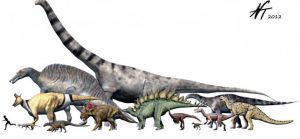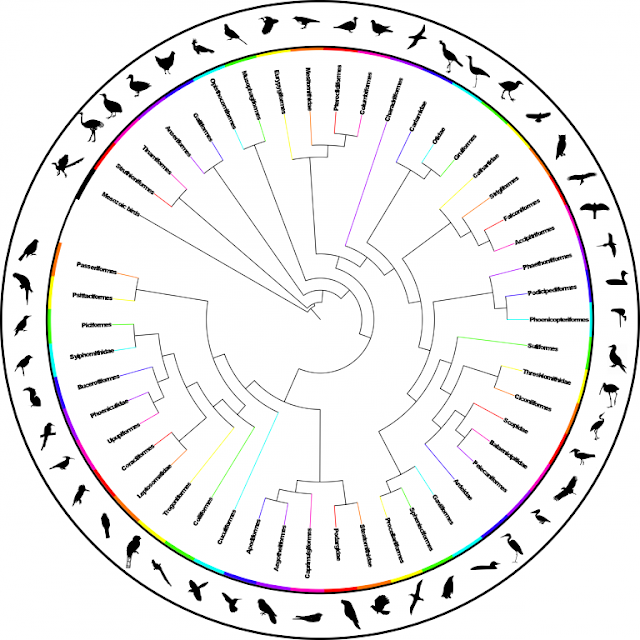
There are more than 10,000 species of bird living on Earth today. If you recognise that birds are living dinosaurs, which overwhelming evidence indicates that they are, then this makes them more diverse than their living mammalian counterparts. So if you take the number of species to mean anything, this means we’re still in the reign of the dinosaurs! These days they’re just mostly a bit smaller and fluffier than their Mesozoic ancestors.
But one massive question still remains for Palaeontologists and Neontologists: Why are there so many bird species around today, when we have relatively so few dinosaurs in the fossil record? This disparity is even more extreme when you consider that while non-avian dinosaurs were around for about 170 million years, there were only ever about 800 or so species of dinosaur, based on current records. The actual number fluctuates through time, as new species are discovered, and others are shown to be invalid through research broadly known as ‘taxonomy’.
Recently, Jostein Starfelt and Lee Hsiang Liow of the University of Oslo made a major step forward in answering one of the key questions related to this: Just how many dinosaur species were there in reality?
Most previous studies of dinosaur diversity have only looked at relative diversity, which assess proportional changes from one time to another. But how do you actually estimate the real total number of dinosaurs through time?
How do Palaeontologists read the fossil record?
One of the major problems in calculating diversity is that the fossil record is a poor representation of the biological part of ecosystems. Animals are preserved differently due to differences in their anatomy. Also, not all animals have the same chance of becoming fossils, based on where they happen to find their final resting place.
Furthermore, the geological record is preserved differently through space and time, due to where seas and rivers were to deposit sediment, and due to processes of mountain building and erosion.
Once you get past these two hurdles, humans have then sampled this record differently through time, for example by collecting only from rocks where they know there is a high probability of finding new fossils, also known as the ‘bonanza effect’.
Dinosaurs be TRiPSin’..
All of this variation is broadly known as sampling bias. While many methods have been developed to account for these biases in different ways, Starrfelt and Liow developed a brand new one called TRiPS, which stands for True Richness estimated using a Poisson Sampling Model. This accounts for variation in the sampling of the dinosaur record by estimating both the bias and the overall diversity (richness) based on variation in the number of times each dinosaur species occurs at different points in time. For example, if we know lots of specimens of a particular dinosaur species, we can infer that it has a relatively high preservation potential and collection probability. The authors used this to investigate the dynamics of dinosaur diversity through time, and to assess possible extinction events in their history.
Using this new method, applied to the whole known dinosaur record through the whole of the Mesozoic (Triassic to the end of the Cretaceous), they estimated that 1543-2468 species existed altogether around the globe. While the authors acknowledge that this is a crude estimate, it is largely convergent on previous calculations too.
Importantly, this number is much higher than what is currently known from the fossil record. If you break this down into the three major dinosaur groups, a slightly different pattern emerges. Theropods, the mostly carnivorous group leading to modern birds, had almost twice as many species (1115) than either the long-necked sauropods (513) or bird-hipped ornithischians (508).
Steve Brusatte of the University of Edinburgh is sceptical though: “I would take these numbers with an ocean full of salt”, he said. “There are over 10,000 species of birds – living dinosaurs – around today. So saying there were only a few thousand dinosaur species that lived during 150+ million years of the Mesozoic doesn’t pass the sniff test. That’s not the fault of the authors. They’ve employed advanced statistical methods that take the data as far as it can go. The problem is the data. The fossil record is horrifically biased. Only a tiny fraction of all living things will ever be preserved as fossils. So what we find is a very biased sample of all dinosaurs that ever lived, and no amount of statistical finagling can get around that simple unfortunate truth.”
Jostein Starrfelt also thinks that there is more work to be done in this domain: “Our estimate of total dinosaur richness of approximately 2000 species was done attempting to combine the sampling probabilities from all stages of the Mesozoic and should be interpreted with caution, and my gut feeling is that the total number of dinosaur species for the whole Mesozoic is higher than our total estimate suggests.”
The future of dinosaur hunting
So what does all of this mean for dinosaur hunters? Well, it suggests that there are still hundreds more to be found out there! So get your hiking boots out and go track some dinosaurs!
Brusatte said “There are huge swaths of the planet and huge stretches of the Mesozoic that have yielded few or no dinosaur fossils. The Middle Jurassic and mid Cretaceous are notoriously poorly sampled, as are Antarctica, Australia, and much of Africa. It’s only been over the last few decades that we’ve come to appreciate the bounty of Chinese dinosaurs, and they keep coming at a furious pace. We still have a lot to find.” Indeed, Starrfelt agreed that their method could be used to “get a better picture of which continents are under-sampled and for which periods (and could thus deserve some more human effort).”
It also hints that there might be something fundamentally different about the evolutionary biology of bird-line dinosaurs, and non-avian dinosaurs. Many studies are beginning to unravel the origins and diversification of modern birds, but these will only truly shed light if they are considered in the wider context of dinosaur diversity through time.
Starrfelt also hinted at his future plans with this line of research. “As with most scientific endeavours I wouldn’t say that TRiPS has solved the major problems of using the fossil record as a source of information about the dynamics of clades; but that it might be a good start. The approach lends itself easily to being extended; in the future we might be able to include information about the ‘human effort’ part of fossil bias by interpreting the sampling rate as the product of a fossilization rate and a ‘discovery probability’, for instance. We’re also in the process of putting TRiPS in a Bayesian framework.” How exciting!
Only by being able to estimate diversity with greater accuracy through space and time can we begin to understand the forces that have shaped the evolutionary history of animals.

Reference:
Jostein Starrfelt et al. How many dinosaur species were there? Fossil bias and true richness estimated using a Poisson sampling model, Philosophical Transactions of the Royal Society B: Biological Sciences (2016). DOI: 10.1098/rstb.2015.0219
Note: The above post is reprinted from materials provided by PLOS Blogs.










